Fiber, Fiber Everywhere: Thread Paper Cloth by Mirka Knaster
September 30, 2022
What does it mean to call oneself a fiber artist? When I transitioned to that title, after years of being a textile artist, I didn’t know how relatively recent the term “fiber art” was coined—the 1950s. It’s not that fiber art didn’t exist before then, but pieces that were made through weaving, knitting, crocheting, quilting, embroidery, knotting, plaiting, twining and so on were considered craft forms and functional objects. However, by the 1960s and ‘70s, there was so much innovation with fibrous material that fiber art became a new category for 2D and 3D work. Since those decades, we’ve witnessed an amazing evolution as artists continue to stretch traditional techniques and embrace materials that previously didn’t exist or weren’t seen as potential for art.
The beauty and joy of creative expression is that artists, whether using the same or diverse techniques and materials, will imagine new possibilities and produce entirely different work. It’s what makes viewing a fiber art exhibit fascinating, exciting, and inspiring. Take, for example, Thread Paper Cloth by a Northern California fiber art group that calls itself Untitled, yet titles its artwork. Its eight members reflect the constant transformation of fiber art.
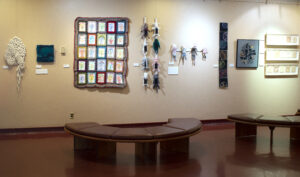
Thread Paper Cloth (installation), 2022. Photo: Dana Davis.
Anne Faught is a mixed media artist interested in incorporating “materials that have had a former function: ephemera, maps, tickets, etc., bringing bits of memory and experience into the work.” For her, art is the way she integrates experiences: “bringing the outside to the inside, the inside to the outside, the invisible to the visible.” Pages from a Life is a paper tapestry constructed after moving from her home of 35 years into a smaller space. As she emptied the attic and sorted box after box, she folded the papers, grouped them sequentially and tied them all together.
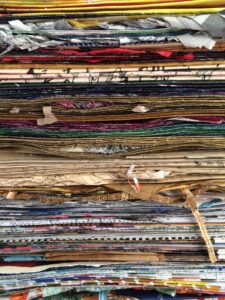
Anne Faught, Pages from a Life (detail), 2018. Paper tapestry with fan-folded paper ephemera, 65 x 12 inches. Photo by the artist.
Susan Kathleen Doyle takes recycled materials to explore different views about political, global and personal issues that concern her and provide inspiration for her work. Her art is inspired by color and relationships, both personal, political and in nature. She uses traditional fiber techniques in non-traditional ways, such as weaving aluminum or pages from a book, or constructing a dress that has more meaning than simply making a fashion statement.
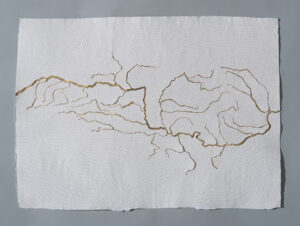
Susan Doyle, Danube, More Precious than Gold, 2021. Hand cut paper, stitched, gold leaf, 27 x 35.5 inches. Photo: Dana Davis.
Carole Beadle is a fiber sculpture artist who uses flax paper, crocheted and knitted wire and patterning techniques for three-dimensional fabric forms. Creating art is a way to give herself space and time to gather her thoughts and express through materials, structure and color what is otherwise difficult to articulate with words.
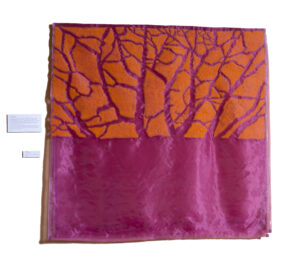
Carole Beadle, Drought, 2016. Needle felted fabric and wool felt, 4.8 x 4.8 inches. Photo: Dana Davis.
Teddy Milder is intrigued by the tension generated between hard and soft surfaces, and their characteristics of both fragility and strength. Her hanging sculpture, no right angles, is her abstract interpretation of neurons invaded by Lewy bodies—clumps of protein that can form in the brain and cause problems with the way it works, including memory, movement, thinking skills, mood, and behavior—a disease attacking her friend Jim, an architect, painter and photographer.
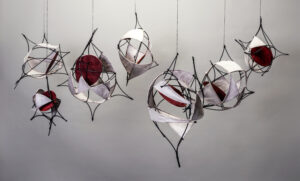
Teddy Milder, no right angles, 2021. Pigmented handmade abaca paper, lashing and waxed linen thread, 6 x 8 x 4 feet. Photo: Sibila Savage.
Chris Motley describes her art form as having originated in early childhood, when her mother taught her how to knit, where she gradually turned the knitting into abstract sculptural forms. Through them she explores texture, color and dimension. Her works reflect a mood, an emotion or idea or a societal condition. Free from any knitting patterns, she lets pieces evolve as they will.
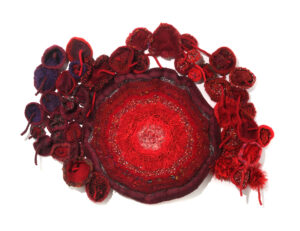
Chris Motley, Garden Galaxy Red, 2020. Handknit, fulled and stitched wool yarn, 20 x 40 inches. Photo: David Felton.
George-Ann Bowers derives “inspiration from visual evidence of biological or geological processes” and celebrates “the infinite intricacies of the natural world.” She employs weaving, hand sewing or free-motion machine embroidery and mixed media construction to “capture fleeting moments in nature’s continuing cycle of creation, destruction, and change.” She is intrigued by the structure of trees, seed pods, and rock formations.
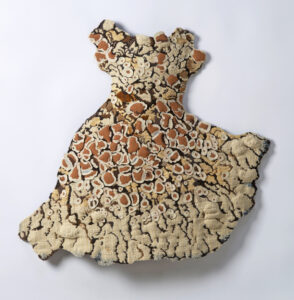
George-Ann Bowers, Fandango, 2021. Handwoven and machine embroidered cotton, wool, rayon silk yarns and sewing thread, 33 x 35 x 3. Photo: Dana Davis.
Katie Richardson processes her thoughts and feelings about disturbing social and political issues through her art. She uses farcical imagery and materials ironically to comment on the status of women, dependence on technology and acquiescence to terrifying new political norms. Her work protests conformity and celebrates imperfection, in defiance of her earlier graphic design career.
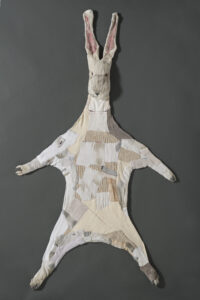
Katie Richardson, Rabbit Skin Rug, 2017. Assemblage, sewn and mended used socks, sweaters, thread, zipper and wax, 72 x 60 inches. Photo: Dana Davis.
Roz Ritter is a visual storyteller who uses hand embroidery and digital photo transfer techniques together to create work that “explore[s] family relationships, transformation and upheaval” and challenge “social mores, societal expectations and class structures.”
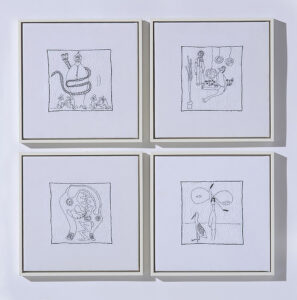
Roz Ritter, Journey on a Sugar Cube – Series Two, 2022. Hand embroidered photo transfer from
artist’s 1970’s journals, 30 x 30 inches. Photo: Dana Davis.
Discovering what other fiber artists are doing with both old and new materials and techniques inspires my own creativity. It’s a good reason for any of us to visit an exhibit in person or online when the next opportunity shows up.
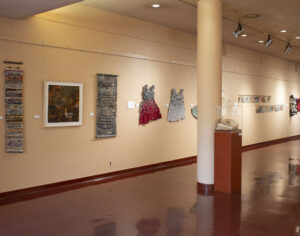
Thread Paper Cloth (installation), 2022. Photo: Dana Davis.
- This article was originally published on Mirka’s blog and she graciously did a slight rewrite for the SDA Blog. Check out her original post here.
- Thread Paper Cloth was on display at the Marin County Civic Center from June 6 to August 4, 2022 in San Rafael, California, US.
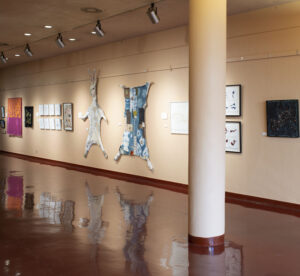
Thread Paper Cloth (installation), 2022. Photo: Dana Davis.
–Mirka Knaster creates 2D and 3D pieces with textiles and handmade paper in her studio on the northern Sonoma coast, where the Pacific Ocean is a daily inspiration. Her work is in many private collections and has been exhibited internationally. She also curates exhibits with a focus on cross-cultural themes and teaches classes in fiber art. A board member of the Textiles Arts Council (Fine Arts Museums, San Francisco), she organizes exhibit and studio tours as well as workshops. She has been blogging about art since 2014.
